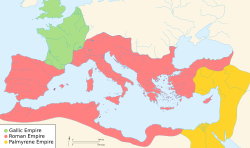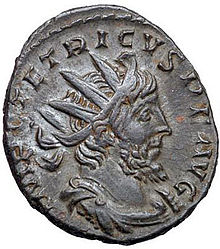Gallic Empire
Gallic Empire
Jump to navigation
Jump to search
Gallic Empire Gallic Roman Empire Imperium Galliarum[note 1] | |||||||||
|---|---|---|---|---|---|---|---|---|---|
260–274 | |||||||||
 The Gallic Empire under Tetricus I by 271 (in green), with the Roman Empire (in red) and the Palmyrene Empire (in yellow). | |||||||||
| Capital | Colonia Agrippina (Cologne) (260–271) Augusta Treverorum (Trier) (271–274)[1] | ||||||||
| Common languages | Latin (official) Regional / local languages | ||||||||
| Religion | Pagan (official) | ||||||||
| Government | Mixed, functionally absolute monarchy | ||||||||
| Emperor | |||||||||
• 260–268 | Postumus | ||||||||
• 268 | Marius | ||||||||
• 268–270 | Victorinus | ||||||||
• 270–274 | Tetricus I | ||||||||
• 274 | Tetricus II | ||||||||
| Historical era | Late Antiquity | ||||||||
• Established | 260 | ||||||||
• Disestablished | 274 | ||||||||
| |||||||||
The Gallic Empire (Latin: Imperium Galliarum)[note 1] or the Gallic Roman Empire are names for a breakaway part of the Roman Empire that functioned de facto as a separate state from 260 to 274.[note 2] It originated during the Crisis of the Third Century.
It was established by Postumus in 260 in the wake of barbarian invasions and instability in Rome, and at its height included the territories of Germania, Gaul, Britannia, and (for a time) Hispania. After Postumus' assassination in 268 it lost much of its territory, but continued under a number of emperors and usurpers. It was retaken by Roman emperor Aurelian after the Battle of Châlons in 276.
Contents
1 History
1.1 Origins
1.2 After Postumus
2 Causes
3 List of Gallic Emperors
4 Consuls of the Gallic Empire
5 Family tree
6 See also
7 Notes
8 References
9 External links
History[edit]
Origins[edit]
The Roman Crisis of the Third Century continued as the Emperor Valerian was defeated and captured by the Sassanid Empire of Persia in the Battle of Edessa, together with a large part of the Roman field army in the east. This left his son Gallienus in very shaky control. Shortly thereafter, the Palmyrene Empire, which came to encompass Egypt, Syria, Judea, and Arabia Petraea also broke away.
The governors in Pannonia staged unsuccessful local revolts. The Emperor left for the Danube to attend to their disruption. This left Postumus, who was governor of Germania Superior and Inferior, in charge at the Rhine border. An exceptional administrator, Postumus had also ably protected Germania Inferior against an invasion led by the Franks in the summer of 260. In fact, Postumus defeated the Frankish forces at Empel so decisively, that there would be no further Germanic raids for 10 years. This all would have combined to make Postumus one of the most powerful men in the western reaches of the Roman empire.

The Gallic Empire at its greatest territorial extent, after its creation by Postumus in 260.
The imperial heir Saloninus and the praetorian prefect Silvanus remained at Colonia Agrippina (Cologne), to keep the young heir out of danger and perhaps also as a check on Postumus' ambitions. Before long, however, Postumus besieged Colonia Agrippina and put the young heir and his guardian to death, making his revolt official. Postumus is thought to have established his capital here or at Augusta Treverorum (Trier),[7] with Lugdunum (Lyon) also becoming an important city in the empire.
The Gallic Empire had its own praetorian guard, two annually elected consuls (not all of the names have survived) and probably its own senate. According to the numismatic evidence, Postumus himself held the office of consul five times.

Coin of Tetricus, last emperor (271–274) of the Gallic Empire
Postumus successfully fended off a military incursion by Gallienus in 263, and was never challenged by him again. However, in early 268 he was challenged by Laelianus, probably one of his commanders, who was declared emperor at Mogontiacum (Mainz) by his Legio XXII Primigenia. Postumus quickly retook Mogontiacum and Laelianus was killed. Postumus himself, however, was overthrown and killed by his own troops, reportedly because he did not allow them to sack the city.[8][9]
After Postumus[edit]
After the death of Postumus, the Gallic Empire began to decline. The Roman Emperor, Claudius Gothicus, re-established Roman authority in Gallia Narbonensis and parts of Gallia Aquitania, and there is some evidence that the provinces of Hispania, which did not recognize the subsequent Gallic Emperors, may have realigned with Rome then.[10][11]
Marius was instated as Emperor upon Postumus' death, but died very shortly after; ancient sources writing much later state that he reigned only two days, though it is more likely, as displayed through the numismatic record, that he reigned for a few months.[12] Subsequently Victorinus came to power, being recognized as Emperor in northern Gaul and Britannia, but not in Hispania.[10] Victorinus spent most of his reign dealing with insurgencies and attempting to recover the Gaulish territories taken by Claudius Gothicus. He was assassinated in 271, but his mother Victoria took control of his troops and used her power to influence the selection of his successor.[10] With Victoria's support, Tetricus was made Emperor, and was recognized in Britannia and the parts of Gaul still controlled by the Empire.[13] Tetricus fought off Germanic barbarians who had begun ravaging Gaul after the death of Victorinus, and was able to re-take Gallia Aquitania and western Gallia Narbonensis while the Roman Emperor, Aurelian, was engaging Queen Zenobia's Palmyrene Empire in the east. He established the imperial court at Trier, and in 273 he elevated his son, also named Tetricus, to the rank of Caesar. The following year the younger Tetricus was made co-consul, but the Empire grew weak from internal strife, including a mutiny led by the usurper Faustinus.[13] By that time Aurelian had defeated the Palmyrene Empire and had made plans to reconquer the west. He moved into Gaul and defeated Tetricus at the Battle of Châlons in 274; according to some sources, Tetricus offered to surrender in exchange for clemency for him and his son before the battle.[13] This detail may be later propaganda, but either way, Aurelian was victorious, and the Gallic Empire was effectively ended.[13]
Causes[edit]
The Gallic Empire was symptomatic of the fragmentation of power during the third-century crisis. It has also been taken to represent autonomous trends in the western provinces, including proto-feudalistic tendencies among the Gaulish land-owning class whose support has sometimes been thought to have underpinned the strength of the Gallic Empire,[14] and an interplay between the strength of Roman institutions and the growing salience of provincial concerns.[15] One of Postumus' primary objectives as emperor was evidently the defence of the Germanic frontier; in 261 he repelled mixed groups of Franks and Alamanni to hold the Rhine limes secure (though lands beyond the upper Rhine and Danube had to be abandoned to the barbarians within a couple of years).[16] In so doing, Postumus positioned himself avowedly as not only the defender and restorer of Gaul, but also as the upholder of the Roman name.[17]
The usurpation of power over Britain and northern Gaul by Carausius just twenty years later reflects a continuing trend by which local loyalties from the landed aristocracy and deteriorating morale in the legions enabled Carausius to seize power in Britain.[citation needed] Similarly with the withdrawal of legions after 408, many Britons desired a localized Roman authority rather than nationalist revolt. The desire for Roman order and institutions was entirely compatible with a degree of national or regional separatism.
List of Gallic Emperors[edit]
The Gallic Emperors are known primarily from the coins they minted.[18] The political and military history of the Gallic Empire can be sketched through the careers of these emperors. Their names are as follows:
Postumus[19] 260–268- (Laelianus 268, usurper)[19]
Marius[19] 268
Victorinus[19] 268–270- (Domitianus 271?, usurper)[20]
Tetricus the Elder[19] 270–274
Tetricus the Younger 270–274 (son of Tetricus; Caesar)- (Faustinus 274?, usurper)
Consuls of the Gallic Empire[edit]
| Year | Consul | Consul |
|---|---|---|
| 260 | Postumus (second time)[21] | Honoratianus[22] |
| 261 | Postumus (third time)[21] | unknown[23] |
| 262 | unknown[23] | |
| 263 | ||
| 264 | ||
| 265 | Postumus (fourth time)[21] | |
| 266 | ||
| 267 | unknown[23] | |
| 268 | Postumus (fifth time)[21] | Victorinus (first time)[23] |
| 269 | unknown[23] | unknown[23] |
| 270 | Victorinus (second time)[21] | Sanctus[23] |
| 271 | Tetricus (first time)[21] | unknown[23] |
| 272 | Tetricus (second time)[21] | |
| 273 | Tetricus (third time)[21] | |
Year and sequence unknown: | ||
| ? | Censor (twice)[23] | Lepidus (twice)[23] |
| ? | Dialis[23] | Bassus[23] |
| ? | "Apr."[23] | "Ruf."[23] |
Family tree[edit]
See also[edit]
- Palmyrene Empire
- Roman governors of Germania Inferior
- Bagaudae
Notes[edit]
^ ab The state was never officially styled as Imperium Galliarum on the official monuments, inscriptions or coins that have survived; rather, the phrase comes from a phrase in Eutropius: Galliarum accepit imperium, "[he took] command of the Gallic provinces".[2] Instead, the titles and administrative structures of the empire followed their Roman models.[3]
^ The year of Postumus' accession was either 259 or 260. In the past, the year 259 was favoured; today, however, most scholars consider that the summer or fall of 260 is the more likely date that Postumus was hailed emperor.[4][5] The exact dating depends on several factors, including when the emperor Valerian was captured and disgraced. Other dates cited in this article must be pushed forward by one year for those who take 259 as the year of Postumus' accession.[6]
References[edit]
^ Bourne, R. J. (2001) Aspects of the relationship between the Central and Gallic Empires in the mid to late third century AD with special reference to coinage studies. Archaeopress. p. 22.
^ Drinkwater 1987, p. 15
^ Drinkwater 1987, pp. 126-127
^ Polfer (Postumus)
^ J.F. Drinkwater (1987), p. 97
^ Drinkwater (1987), pp. 95-106
^ J.F. Drinkwater (1987), The Gallic Empire: Separatism and continuity in the north-western provinces of the Roman Empire, Franz Steiner Verlag, Stuttgart, pp. 24-27.
^ Aurelius Victor 33.8.
^ Eutropius 9.9.1.
^ abc Polfer, Michel (June 3, 2000). "Victorinus (A.D. 269–271)". De Imperatoribus Romanis: An Online Encyclopedia of Roman Rulers and Their Families. Retrieved July 10, 2009.
^ Weigel, Richard D. (June 19, 2001). "Claudius II Gothicus (268–270)". De Imperatoribus Romanis: An Online Encyclopedia of Roman Rulers and Their Families. Retrieved July 10, 2009.
^ Polfer, Michael (June 24, 1999). "Marius (A.D. 269)". De Imperatoribus Romanis: An Online Encyclopedia of Roman Rulers and Their Families. Retrieved July 10, 2009.
^ abcd Polfer, Michel (January 28, 2000). "Tetricus I (AD 271–273)". De Imperatoribus Romanis: An Online Encyclopedia of Roman Rulers and Their Families. Retrieved July 10, 2009.
^ Drinkwater (1987), p. 239.
^ Drinkwater (1987), pp. 247-248.
^ Drinkwater (1987), pp. 226-227.
^ Drinkwater (1987), pp. 28 and 240; the Gallic emperors are called adsertores Romani nominis in the Historia Augusta.
^ Drinkwater (1987), p. 16.
^ abcde Drinkwater (1987), p. 102.
^ Richard Abdy. "The Domitian II coin from Chalgrove: a Gallic emperor returns to history". Retrieved 29 October 2013.
^ abcdefgh Drinkwater (1987), p. 188.
^ Potter (2004), p. 260
^ abcdefghijklmn Drinkwater (1987), pp. 128-130.
External links[edit]
- Gallic Consuls
- Gallic Empire
- Jona Lendering, "Gallic Empire"
- Gallic Empire coinage
Laelianus 269 | Postumus 260-269 | ||||||||||||||||||||||||||||||||||||||||||||||||||
Marcus Aurelius Marius 269 | Postumus Junior 260-269 | Victoria 271 | |||||||||||||||||||||||||||||||||||||||||||||||||
Tetricus I 271-274 | Victorinus 268-271 | ||||||||||||||||||||||||||||||||||||||||||||||||||
Tetricus II 271-274 | Victorinus Junior 271 | ||||||||||||||||||||||||||||||||||||||||||||||||||
Categories:
- 260 establishments
- 274 disestablishments
- Gallic Empire
- Roman Gaul
- Former empires in Europe
- Crisis of the Third Century
(window.RLQ=window.RLQ||).push(function()mw.config.set("wgPageParseReport":"limitreport":"cputime":"0.608","walltime":"0.692","ppvisitednodes":"value":11602,"limit":1000000,"ppgeneratednodes":"value":0,"limit":1500000,"postexpandincludesize":"value":64269,"limit":2097152,"templateargumentsize":"value":24442,"limit":2097152,"expansiondepth":"value":11,"limit":40,"expensivefunctioncount":"value":4,"limit":500,"unstrip-depth":"value":1,"limit":20,"unstrip-size":"value":17412,"limit":5000000,"entityaccesscount":"value":0,"limit":400,"timingprofile":["100.00% 584.666 1 -total"," 36.54% 213.628 1 Template:Infobox_Former_Country"," 28.15% 164.602 3 Template:Infobox"," 27.35% 159.891 1 Template:Lang-la"," 12.83% 74.998 2 Template:Reflist"," 9.22% 53.923 7 Template:Family_tree"," 8.43% 49.311 5 Template:Cite_web"," 7.69% 44.983 1 Template:Citation_needed"," 6.78% 39.654 7 Template:Family_tree/step2"," 6.73% 39.359 1 Template:Fix"],"scribunto":"limitreport-timeusage":"value":"0.243","limit":"10.000","limitreport-memusage":"value":11653277,"limit":52428800,"cachereport":"origin":"mw1295","timestamp":"20180902175243","ttl":1900800,"transientcontent":false);mw.config.set("wgBackendResponseTime":94,"wgHostname":"mw1273"););

 Clash Royale CLAN TAG
Clash Royale CLAN TAG